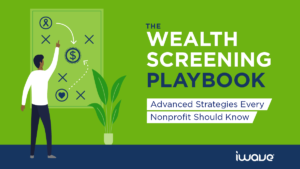When I first moved to Greater Tampa Bay, Florida from Greater Philadelphia, the big excitement was spotting dolphins and manatees. It was so cool! After years on the beach, I could tell just by the way the water was moving which marine life was causing it, including dolphins and manatees. Spotting the dolphin fin or hearing a manatee “snort” clinched the identification. In prospect research, I’ve learned to spot the whales – the major gift prospects that are capable of gifts of $10M or even $100M or more.
Back when I first started my research career, I was just learning how to spot the whales. It was back when wealth screenings were just gaining traction and vendors were fixing bloopers like valuing real estate by summing all of the real estate tax assessments on the same property. I distinctly remember thinking that machine-generated capacity ratings were worthless when it came to understanding a prospect’s wealth. And I was right. (And wrong. And much younger!)
Prospect wealth screenings do a great job of quickly segmenting large lists of donor prospects. And then research can focus on those most likely to have high capacity. This is VERY valuable!
But those same machine-generated capacity ratings rarely spotted the whales — and often mistook a manatee for a whale. Someone with a net worth of $5M is very different from someone at $30M net worth and there again very different from someone with $100M or $1B or more in net worth. But the machine-generated capacity ratings often confuse them or lump them altogether.
Do you know how to spot the whales – those donor prospects capable of transformative giving?
Russell James, J.D., Ph.D., CFP® is a professor at Texas Tech University with a focus on the psychology of philanthropy. He likes to say that the problem with fundraisers – and by extension, fundraising researchers – is that they don’t understand wealth. And he’s right.
But even before the psychology of giving becomes valuable to know, understand, and apply, a fundraising researcher needs to recognize the key industries that generate tremendous wealth. Industries such as private company ownership; investors such as angels, private equity, and venture capitalists; investment and wealth advisors; banking; and others.
Next you want to build an understanding of how wealth is generated in those industries and the milestone stages of those careers. In other words, you begin to notice the details. These details are the indicators or “tells” that suggest which marine life is causing those distinctive ripples under the water – which prospect in a particular industry is likely to be a dolphin and which one is likely to be a whale.
And, if you’re lucky, you will spot the telltale dorsal fin of a dolphin or witness the water spout of a whale. You’ll find a high-income couple that also has a portfolio of commercial real estate or discover your prospect is five years into his latest private equity firm – and started his career in the field FIFTY years ago!
But if you can’t discern those early details, those ripples in the water, then you probably won’t be patient enough or dig deep enough to positively identify the dolphin or whale.
And this brings us around to machine-generated capacity ratings again. The information needed to positively identify the whales is frequently not available in a way that can be matched to the donor name and/or quantified in a capacity rating by a machine. Machine learning is making big improvements here, but for now, it still takes a human being with applied knowledge in spotting whales.
Thankfully, you don’t have to wander around alone, trying to get better at spotting whales.
You can join me and other prospect research professionals in the FREE Forums available through the Prospect Research Institute. Have discussions, ask and answer questions, and expand your network.
Go on – get chatting!

